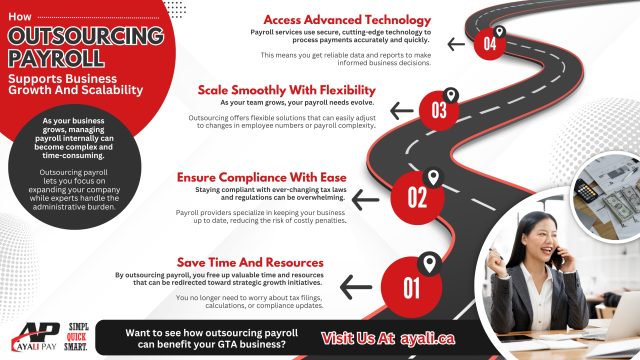June 2025 - Page 2 of 2 - Ayali Pay - Simple. Quick. Smart.
Payroll errors in Canada are more common than you think, and they can cost businesses dearly. These mistakes can lead to unpaid wages, employee lawsuits, government penalties, and a damaged reputation. In Ontario alone, employers owed a total of $60 million in unpaid wages between 2017 and 2024 that the government couldn’t collect.
The true cost of payroll mistakes goes far beyond dollars and cents. Below, we explore real-world case studies—many close to home in Canada—where payroll errors led to legal, financial, or reputational fallout. Each example also shares lessons on how to prevent the same from happening to you.
Case Study 1: The Phoenix Pay System Disaster (Federal Government of Canada)

One of the most infamous payroll errors in Canada wasn’t at a private company at all, but within the federal government. The Phoenix pay system, launched in 2016, was meant to streamline federal payroll. Instead, it turned into a colossal debacle. The system suffered hundreds of thousands of payroll errors, from employees being underpaid or not paid at all to others being overpaid by mistake. In fact, an estimated 62% of federal workers experienced pay errors under Phoenix.
The consequences were devastating. Some public servants drained their savings or maxed out credit cards while waiting for their missing pay. One Canadian Revenue Agency employee even saw her paycheques drop to $0 due to false “overpayment” deductions—she ultimately defaulted on her mortgage and lost her home as a result.
The financial cost to taxpayers has been enormous. The government has spent years and billions of dollars trying to fix Phoenix. As of mid-2024, the federal government had incurred about $3.7 billion in costs coping with the Phoenix fiasco. This includes hiring extra staff and technical support to sort out the mess.
On top of that, Ottawa has paid roughly $711 million in compensation to employees for stress, hardship, and other damages caused by the pay errors. Each affected worker was offered a lump sum for pain and suffering. Multiple audits and parliamentary inquiries were launched to understand how things went so wrong.
What was done to prevent future issues?
After nearly a decade of frustration, the government finally decided that enough is enough. Plans are underway to replace the Phoenix system by 2026 with a new, hopefully reliable, payroll platform. The Phoenix disaster taught a hard lesson: even large institutions need rigorous testing and oversight for payroll systems. A small glitch can snowball into a national crisis. For everyday businesses, the takeaway is clear – payroll errors in Canada can escalate quickly, so use reliable software, double-check calculations, and address issues promptly before they spin out of control.
Case Study 2: CIBC’s $153 Million Overtime Oversight

CIBC’s headquarters in Toronto. The bank faced a major class-action lawsuit over unpaid overtime, resulting in a $153 million settlement after 15 years of litigation.
One of the largest corporate payroll errors in Canada involved the Canadian Imperial Bank of Commerce (CIBC) and the mismanagement of employee overtime. The issue stemmed from CIBC’s overtime policy, which required pre-approval by managers. In practice, many front-line staff worked extra hours to serve customers but were not compensated for their overtime if it hadn’t been formally approved in advance. Essentially, the bank’s policy enabled work to be done off the clock, which violated labour standards. A CIBC teller named Dara Fresco noticed this unfair system, and in 2007, she became the representative plaintiff in a class-action lawsuit on behalf of thousands of employees.
After a protracted legal battle lasting well over a decade, the courts found CIBC had breached its overtime obligations to about 31,000 employees across Canada. Facing the likelihood of hefty damages, CIBC agreed in 2023 to settle the class-action for $153 million. The settlement money is being paid out to around 30,000 current and former tellers, personal bankers, and other staff to compensate for unpaid overtime hours over many years. Not only did this payroll mistake cost CIBC a huge sum, but it also meant years of negative press and trust issues with employees. Notably, other Canadian banks have faced similar overtime lawsuits; Scotiabank, for example, settled a case in 2014.
What can be done to prevent such issues?
To avoid legal and financial consequences, employers should implement clear and compliant overtime policies, ensure all hours worked are accurately recorded, and compensate employees for all overtime worked. Regular training for managers and the use of reliable payroll systems can further help ensure compliance with labour standards and reduce the risk of disputes.
The lesson for employers is to ensure payroll policies fully comply with labour laws and reality. If your staff end up working extra hours, you need a system to record it and make sure they get paid, period. Clear communication, proper time-tracking tools, and internal audits of timesheets can help prevent payroll errors like unpaid overtime from occurring. No company wants to be hit with a surprise multi-million dollar payout for something that was entirely avoidable.
Case Study 3: Small Businesses Fined for Unpaid Wages (Ontario)
Payroll mistakes aren’t just a big business problem. Small and mid-sized employers across Canada have also faced serious consequences for errors, sometimes with their very existence at stake. A recent example from Ontario shows how even a relatively small payroll issue can lead to legal trouble. In this case, two companies (Aemulus Corporation and Jackman Enterprises) and their director failed to pay about $85,000 in wages owed to six employees between 2019 and 2020. The employees filed complaints with Ontario’s Ministry of Labour, which investigated and ordered the companies to pay the outstanding wages. However, the employers simply ignored the orders.
Ontario authorities took them to court. The two companies and the director were hit with fines totaling $86,000 for failing to comply with the law. Under Ontario’s Employment Standards Act, ignoring an order to pay wages is an offense.
What can be done to prevent such issues?
The broader lesson for payroll errors in Canada is clear: always pay your people what they’re owed, and never ignore government orders or deadlines. Small businesses should familiarize themselves with provincial employment standards (like overtime pay rules, minimum wage, vacation pay, etc.) and set up proper payroll processes to avoid inadvertent mistakes.
If an error does happen – for example, you discover an employee wasn’t paid for overtime or a clerical mistake shorted their pay – correct it immediately. Provinces have mechanisms to file complaints anonymously, so you might not even know there’s a problem until an inspector comes knocking.
Case Study 4: Wage Underpayments at Woolworths (Australia’s $300 Million Payroll Blunder)

Payroll errors aren’t unique to Canada; companies around the world have learned the hard way how costly mistakes can be. One dramatic example comes from Australian retail giant Woolworths, which in 2019 admitted it had underpaid thousands of employees for nearly a decade. In what became Australia’s biggest wage underpayment scandal, Woolworths confessed it owed staff as much as $300 million in back pay. An internal review uncovered that at least 5,700 salaried employees (mostly department managers in supermarkets) had been shortchanged over nine years. The root cause was a payroll miscalculation: these managers were on fixed annual salaries supposedly high enough to cover any overtime, but in reality many regularly worked hours that entitled them to more pay under law than their salary provided. In short, thousands of employees were working overtime and not receiving the proper overtime or penalty rates because of wrong payroll assumptions.
The fallout was swift and serious. Woolworths’ revelation prompted a public outcry, an investigation by Australia’s Fair Work Ombudsman (the labour regulator), and accusations of “wage theft” in the media. The company’s CEO issued a public apology, stating “we have let [our employees] down” and promised to pay everyone back with interest as quickly as possible. Woolworths took a one-time charge of up to $300 million on its books to cover the remediation, which included immediate interim payments to affected staff before Christmas that year. The scandal also triggered broader industry soul-searching, with other large Australian companies auditing their own payrolls for errors. Regulators warned that companies would be held to account for such breaches even if they self-report.
What was done to prevent future issues?
Woolworths expanded its payroll review to all its business units and worked with outside auditors to identify and fix any other pay discrepancies. The company overhauled its compliance systems and committed to ensuring all managers’ salaries at least meet minimum award (overtime) requirements going forward.
The clear takeaway for employers everywhere is that payroll errors can lurk for years if you’re not careful, especially when dealing with complex overtime and salary structures. Regular audits, whether internal or by a third party, are essential. Make sure any “all-inclusive” salaries truly cover all the hours worked, or else track overtime and pay it out. What started as small calculation errors at Woolworths snowballed into hundreds of millions in liabilities. No business, in Canada or elsewhere, can afford that kind of mistake.
Why Ayali Pay Is Your Trusted Choice
You’ve seen how payroll errors in Canada and beyond can wreak havoc—from massive legal settlements to broken trust and burned finances. The good news is, you don’t have to navigate these payroll minefields alone. Ayali Pay is here to help your business get payroll right every time. We offer hassle-free payroll services in Toronto that businesses can rely on, with end-to-end support that ensures your employees are paid accurately and on schedule. Our expert team stays on top of Canadian payroll compliance rules, so you won’t lose sleep over CRA audits or missing remittances. Whether you’re a small startup or a growing company, Ayali Pay provides fully managed payroll services in Canada to eliminate errors and keep you on the right side of the law.
The true cost of payroll errors is one risk you don’t need to take. Let Ayali Pay save you time, protect your business from costly mistakes, and give you the confidence that your payroll is in the best hands. Contact us today!
Remote work has reshaped how businesses operate across Canada. The rise of hybrid and fully remote teams means companies often have employees working from different provinces and territories. Managing payroll for this distributed workforce brings new challenges. Payroll must comply with various federal and provincial laws, tax rules, and reporting requirements.
In this blog, you will find a clear and professional guide to handling payroll for remote teams in Canada. The focus is on understanding:
- The challenges of cross-provincial payroll
- Tax implications for remote employees
- The benefits of cloud-based payroll systems
This information helps businesses avoid errors, remain compliant, and provide fair, timely pay to their remote workforce.
Cross-Provincial Payroll Challenges in Canada
Canada’s federal system divides payroll responsibilities between the federal government and the provinces. This means payroll managers must navigate a complex set of regulations, rates, and remittance rules when employees work in different provinces.
1. Understanding Provincial Income Tax Withholding
In Canada, income tax is collected by both the federal government and the provinces or territories. Each province has its own tax rates and credits, which means payroll withholding must be adjusted depending on the employee’s work location.
- Federal Tax:Uniform across Canada, deducted based on CRA tables.
- Provincial Tax:Varies by province; payroll must withhold according to the employee’s physical location.
For example, Quebec has its own provincial tax system and collects provincial taxes separately from the federal government. Employers with employees in Quebec must withhold provincial income tax directly to Revenu Québec rather than the CRA.
If an employee works remotely from multiple provinces within a year, payroll systems must adapt. Employers need to:
- Track where employees are working on a day-to-day or monthly basis.
- Adjust provincial tax deductions accordingly.
- Update payroll records when employees permanently change provinces.
Payroll accuracy is critical. Incorrect provincial tax deductions may cause employees to face unexpected tax bills or refunds at year-end and could trigger CRA compliance reviews.
2. Provincial Payroll Contributions and Levies
In addition to income tax, many provinces impose payroll contributions that employers must handle.
- Health Premiums or Levies:Some provinces, such as British Columbia and Ontario, have health premiums or similar levies that must be deducted or paid by employers on behalf of employees.
- Workers’ Compensation Board (WCB) Contributions:Each province manages its own WCB program, which provides workplace injury insurance. Employers register with the WCB in provinces where their employees work and remit contributions based on payroll and industry risk.
- Employment Insurance (EI):Though EI is federally regulated, contribution rates can vary slightly based on provincial maximums.
Employers with remote teams must register with multiple provincial agencies and handle each contribution according to the province’s rules. Failure to do so could lead to penalties or delayed employee benefits.
3. Employment Standards: Vacation, Statutory Holidays, and Termination Pay
Employment standards legislation in Canada is province-specific. Payroll managers must understand and apply the correct rules related to:
- Vacation Pay:Minimum vacation entitlements vary. For instance, Ontario requires at least two weeks of paid vacation, whereas some provinces set minimums at four percent of earnings.
- Statutory Holidays:Provinces differ in the number and names of statutory holidays recognized. Employers must pay holiday pay or substitute days accordingly.
- Termination Pay:Notice periods and severance pay vary provincially and must be reflected accurately in final payroll calculations.
When managing payroll for remote workers in different provinces, payroll teams need to be familiar with each jurisdiction’s employment laws to comply properly.
4. Payroll Reporting, Remittances, and Record-Keeping
Employers must submit payroll deductions and employer contributions to the CRA and provincial authorities on schedule. Reporting includes:
- Payroll tax remittances (income tax, CPP, EI) to CRA monthly or quarterly.
- Workers’ compensation payments to respective provincial boards.
- Provincial health premiums or levies as required.
Employers must also prepare and file T4 slips that show income and deductions, ensuring they reflect the employee’s provincial location correctly.
Handling multiple provinces means managing several accounts, meeting different deadlines, and ensuring records meet local requirements. These challenges increase the administrative burden.
Remote Work Tax Implications in Canada

Remote work arrangements present several unique tax considerations that affect payroll compliance.
1. Employee Tax Residence and Work Location
In general, the employee’s tax residence and place of employment determine payroll tax obligations.
- If an employee works remotely full-time from a province, the employer must apply that province’s tax and employment rules, even if the company is based elsewhere.
- For employees who work in multiple provinces throughout the year, payroll managers should allocate wages earned in each province and apply the corresponding tax rates.
CRA guidance confirms that withholding depends on the employee’s place of work, not solely on the employer’s location.
2. Taxable Benefits Related to Remote Work
Remote employees often receive reimbursements or allowances for expenses such as:
- Home office supplies
- Internet and phone costs
- Equipment (computers, chairs, desks)
Employers must classify these reimbursements correctly. The CRA distinguishes between:
- Non-taxable reimbursements:Direct payment for reasonable business expenses that employees incur.
- Taxable benefits:Items that provide personal benefits or exceed CRA limits.
Incorrectly treating taxable benefits as non-taxable could lead to payroll errors and penalties.
Employers should:
- Keep clear documentation of expenses.
- Communicate policies on remote work reimbursements to employees.
- Adjust payroll to include taxable benefits when required.
3. Permanent Establishment and Corporate Tax Risks
A remote employee working in a province without a corporate presence could create a permanent establishment for the employer. This means the company might be subject to provincial corporate income tax.
Factors determining permanent establishment include:
- The employee’s authority to conclude contracts in the province.
- Duration and nature of business activities conducted remotely.
Employers should consult tax advisors to assess whether remote employees create permanent establishments and prepare for associated tax obligations.
4. Employment Insurance (EI) and Canada Pension Plan (CPP) Considerations
Employers must deduct EI and CPP contributions based on the employee’s province of residence. Contribution rates and maximums can differ slightly by province.
Payroll teams need to:
- Stay current on annual contribution limits and rates.
- Update payroll systems as CRA and provincial parameters change.
- Ensure accurate year-end reporting for employee CPP and EI contributions.
Cloud-Based Payroll Tools for Remote Teams in Canada

Managing multi-provincial payroll manually is complex and prone to errors. Cloud-based payroll platforms simplify the process by automating calculations, tax deductions, reporting, and compliance.
1. Centralized Management Across Provinces
Cloud payroll solutions let you:
- Manage employee records from a single dashboard regardless of their work location.
- Automatically calculate provincial tax withholdings based on employee addresses or work locations.
- Update tax rates in real time as CRA or provincial authorities adjust tables.
This centralization reduces risk, saves time, and improves payroll accuracy.
2. Automated Filing and Payment
Leading cloud payroll platforms connect directly to the CRA and provincial agencies to:
- File remittances automatically on behalf of employers.
- Generate and submit T4 slips and related year-end documents.
- Provide digital pay stubs and tax forms to employees securely.
Automation cuts down on late filings, penalties, and manual paperwork.
3. Compliance Alerts and Audit Preparation
Good payroll software monitors compliance changes and alerts payroll managers to updates in tax laws or provincial regulations.
Features often include:
- Automated audits of payroll data to catch discrepancies.
- Easy export of data for CRA audits or trust examinations.
- Record-keeping tools to demonstrate compliance during CRA payroll examinations.
4. Integration with HR and Accounting Systems
Cloud payroll platforms commonly integrate with HR management, time tracking, and accounting software. This:
- Minimizes data entry errors.
- Ensures consistency across systems.
- Enables easier tracking of remote work schedules and locations.
5. Employee Self-Service
Many platforms offer portals where remote employees can:
- Access pay stubs and tax slips anytime.
- Update personal and work location information.
- Request time off or manage benefits.
This reduces administrative questions and improves employee satisfaction.
Best Practices for Managing Payroll for Remote Teams in Canada

Effective payroll management for remote and hybrid teams requires consistent processes and attention to detail.
1. Maintain Accurate Employee Location Records
It is essential to:
- Collect initial work location data at hiring.
- Require employees to notify HR or payroll if their location changes.
- Track temporary work-from-different-province arrangements carefully.
Accurate location data ensures correct provincial tax deductions and employment law compliance.
2. Regularly Review Payroll Deductions and Provincial Contributions
Payroll administrators should:
- Conduct periodic audits of tax deductions and provincial remittances.
- Update employee records and payroll setups when employees relocate.
- Verify that vacation pay, statutory holidays, and employment standards match the employee’s province.
3. Invest in a Reliable Cloud-Based Payroll Solution
Choose payroll software that supports:
- Multi-provincial payroll with real-time tax updates.
- Automated filings to CRA and provincial agencies.
- Employee self-service and mobile access.
- Integration with HR and accounting tools.
4. Communicate Payroll Policies Clearly
Employees should understand:
- How remote work affects their payroll deductions.
- Which reimbursements are taxable or non-taxable.
- Who to contact for payroll questions.
Clear communication reduces payroll disputes and confusion.
5. Stay Current with CRA and Provincial Updates
Tax laws and employment standards change regularly. Employers should:
- Subscribe to CRA newsletters and provincial government updates.
- Attend payroll seminars or webinars.
- Consult payroll professionals when in doubt.
6. Prepare for CRA Payroll Audits and Trust Examinations
CRA conducts audits and trust examinations to verify payroll compliance. Employers should:
- Keep detailed payroll records for all employees.
- Document all payroll policies and employee communications.
- Use payroll tools that generate audit-friendly reports.
Addressing Payroll Challenges for Seasonal or Mobile Remote Workers

Some businesses have employees who work remotely but travel frequently between provinces. Examples include:
- Sales representatives
- Field service workers
- Consultants
Payroll for these workers requires:
- Accurate time tracking by location.
- Allocating wages earned per province.
- Applying appropriate tax and employment standards for each work period.
Cloud payroll systems that integrate with time tracking tools can simplify these calculations.
Understanding CRA Payroll Audits and Their Importance
CRA payroll audits, also known as payroll examinations, verify employer compliance with tax withholding and remittance requirements.
- Audits can focus on employment classification, benefit reporting, and tax deductions.
- Remote work and cross-provincial issues often attract CRA attention due to complexity.
- Maintaining accurate payroll records and using compliant payroll systems reduces audit risks.
Employers should cooperate fully with CRA during audits and use them as opportunities to improve payroll practices.
Payroll for Remote Teams in Canada: Key Takeaways

- Canada’s provincial payroll rules require employers to carefully manage cross-provincial tax deductions, employment standards, and remittances.
- Remote work shifts the employee’s work location, which often dictates payroll tax obligations.
- Taxable benefits for remote work must be handled correctly to avoid payroll errors.
- Cloud-based payroll platforms provide automation, compliance monitoring, and multi-provincial support that simplify payroll management.
- Keeping accurate employee location records and communicating payroll policies clearly is vital.
- Preparing for CRA payroll audits and examinations through sound record-keeping and software tools is essential.
Ayali Pay – Your Trusted Partner in Payroll Compliance
Ayali Pay delivers expert payroll services tailored for companies in Toronto managing remote and hybrid teams. Our all-inclusive payroll services in Toronto cover everything from CRA trust examinations in GTA to payroll audits, helping you stay compliant and confident.
With fully managed payroll service provider in Canada, Ayali Pay removes the complexity of cross-provincial payroll tax remittances, deductions, and reporting. We offer transparent, hassle-free payroll services in Toronto, designed to meet the needs of small and large businesses alike.
If you seek reliable Canadian payroll compliance and efficient Toronto payroll solutions, contact Ayali Pay today for trusted support that keeps your payroll accurate, timely, and audit-ready.




